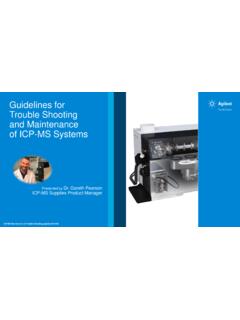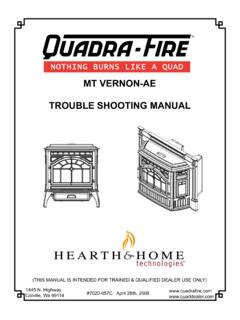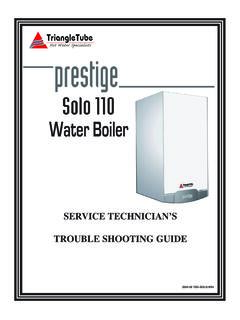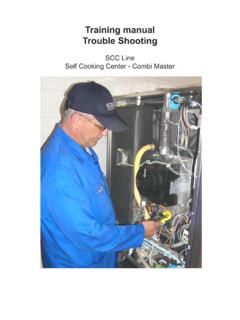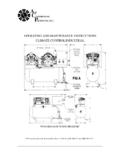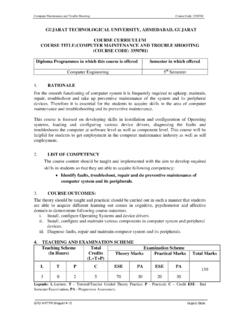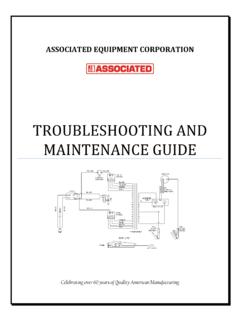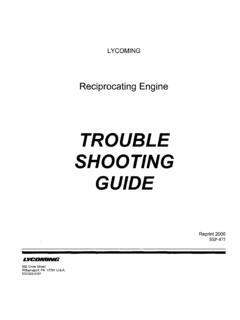Transcription of Hydra Slide System Trouble Shooting
1 THE HYDRAULIC Slide OUT System GENERAL OPERATION & Trouble Shooting NOTES The hydraulic Slide -out System is a fixed displacement System , using double acting hydraulic cylinders to open and close a room assembly built into the travel trailer or motor home. Cylinders are energized by a 12 volt DC high pressure hydraulic pump through electrically operated directional valves. The pump is supplied the 12V power from the vehicle s battery circuit. A wall mounted, three (3) position momentary switch activates the room movement. For safety purposes, the switch must be pressed continuously during the room movement. Operation of the System When the momentary switch is held to activate the 12V motor, it closes the solenoid valve circuit. This causes the pump to start and simultaneously shifts the valve. Fluid is pumped through the valve and into the cylinder ports. Depending on the switch position, the room will either move to extend or retract to the home position.
2 When a single cylinder is used in the System , the cylinder becomes a part of the reservoir fluid volume. As the cylinder extends, the fluid is pumped from the rod end of the cylinder to the base end. The extra fluid needed to fill the base end of the cylinder is pulled from the reservoir. As the room is retracted, the fluid moves from the rod end to the base end. The extra fluid is returned to the reservoir. When two cylinders are used in tandem to move the room, one cylinder is called the Master and the other is called the Slave . NOTE: in this System the oil between the two cylinders never goes to the reservoir. This is the most important feature that the repairman or troubleshooter must understand when diagnosing or repairing this type of System . The Master cylinder (the larger cylinder) receives fluid from the pump into the rear port, which causes it to extend. As this cylinder extends, it pushes the fluid from the front port out.
3 The fluid moves through a hose that is attached to the rear port of the Slave cylinder, which causes it to extend. The fluid from the front of the Slave cylinder is pushed out of the port and moves through a hose that returns the fluid back to the pump and reservoir. When the process is reversed to retract the room, the pump will send fluid through the hose to the front port of the Slave cylinder. As the fluid enters the front port, it will force the room to close. As the Slave cylinder retracts, the fluid at the rear will be forced to the front port of the Master cylinder. It will then be retracting at the same rate as the Slave cylinder and the room will evenly close. The fluid from the rear of the Master cylinder will be returned to the pump and reservoir. For a better understanding of how the System functions, refer to illustrations HS-1 thru HS-4 following this section. NOTE: The typical installation of the Hydra - Slide System assembly is to assemble the larger diameter Master cylinder toward the front of the vehicle and the Slave cylinder toward the rear.
4 All illustrations show the System set up in this configuration. Identify the Master and Slave cylinders on your travel trailer by measuring the outside diameter of the body. The Master cylinder will be 1 7/8 diameter and the Slave cylinder will be 1 diameter. When removing cylinders for replacement, make certain that the Master and Slave cylinders are replaced in the same Slide tube from which they were removed. The early Production of this System proved to be unreliable for two reasons: 1. The room would drift out while driving to or from a location. This problem was fixed by placing a Check Valve in the System , as noted in the following paragraph. 2. As fluid would be lost from the hose between the Master and Slave cylinder, the room would not close evenly. As the room would extend, the front of the room would get ahead of the rear. As the room would retract, the rear of the room would retract ahead of the front of the room.
5 If this condition is not corrected, the room will be damaged. This problem was initially solved by the addition of a small in-line check valve, and was eventually replaced by a Phasing Valve mounted directly on the pump. Custom Cylinders International, Inc. has developed a pump System that eliminates the add-on valve by integrating a special logic circuit to check the volume of fluid between the Master and Slave cylinders on each activation cycle. FOLLOWING ILLUSTRATIONS REPRESENT 3 Hydra - Slide FLEETWOOD TRAVEL TRAILER- 2 CYLINDER ROOM CIRCUITS ILLUSTRATION HS-1 ILLUSTRATION HS-2 ILLUSTRATION HS-3 ILLUSTRATION HS-4 MANUAL CLOSING OF ROOM Most systems will use a Check Valve that blocks the reverse flow of fluid to keep the room closed. As a safety precaution there are usually mechanical locks to hold the room in place during transit on the highway.
6 Should it be necessary to manually retract the room due to pump failure or some other problem, remove the hose at the pump that supplies fluid to the rear port of the Master cylinder and place it in a container to catch a considerable amount of fluid. Remove the hose at the pump that supplies fluid to the front port of the Slave cylinder. Attach a come-along to the door-side mainframe and the other end to the end of the Slave Slide tube. See diagram number HS-5. As the room is gradually forced in to the closed position, fluid will move from the Slave cylinder to the Master cylinder and force it to retract. ILLUSTRATION HS-5 Electrical System maintenance For optimum performance, the Slide out System requires full battery current and voltage. The battery must be maintained at full capacity. Other than good battery maintenance, check the terminals and other connections at the battery, the control switch, and the pump motor for corrosion, tightness, or damage.
7 Check motor leads under the trailer or motor home chassis. Since these connections are subject to damage from road debris, be sure they are in good condition. Mechanical maintenance Although the System is designed to be almost maintenance free, actuate the room once or twice a month to help keep the seals and internal moving parts lubricated. The best time to check for external leaks in the System is when the unit is moved from the parking spot, by looking for any signs of hydraulic fluid. Hydraulic System troubleshooting The hydraulic System is only one of several interrelated Slide out room System components. When something restricts from travel on front, rear, or both, System performance will be unpredictable. It is very important that both cylinders are allowed to travel full distance (full stroke). Remember that the hydraulics are tied very closely to the electrical System and one problem might appear to be a hydraulic problem and will actually be an electrical issue.
8 Testing for hydraulic valve performance This test will check for operation of the phasing valve. Perform this test with extreme caution or damage can occur to the room. Never allow the room to run more than two inches out of alignment. When retracting the room place a 12 to 14 long 2X4 between the chassis and S1 Slide tube, and flange end (flange that support the room). This will restrict the front cylinder in movement and allow the back to continue to move. DO NOT ALLOW A MISALIGNMENT OF MORE THAN 1 TO 2 INCHES. DAMAGE CAN OCCUR TO THE VEHICLE AND ROOM. After misalignment has occurred, stop and measure both front and rear extension. Let room set for a couple of minutes and re-measure. If there is movement, check for leaking fittings. If no movement, extend room to full open position, (be sure to allow room to realign itself) and measure. Let set for a few minutes and then re-measure.
9 If there is no movement, retract and check to see if room is sealed. Note: it is normal for the front of the room to run ahead of rear one half to three quarter inch before closing. Be cautious that the misalignment does not cause any damage to interior room. When fully extended, the room should realign itself. If it does not realign, it may be required that the pump pressure be set a little higher. CAUTION: DO NOT SET THE PUMP PRESSURE HIGHER THAN 1800 PSI. Operate room through at least two complete cycles to make certain that the front and rear are in alignment during travel and stop simultaneously. Test is now complete. NOTE: It is OK for the front to stop first and the back to travel one half to three quarter inch before closing. It is not OK for the back to stop first. This will cause the front to not close fully. Cycle the room one more time to see if this corrects the misalignment.
10 Electrical troubleshooting Since there are very few serviceable parts for the pump, motor, or reservoir, electrical troubleshooting and service by the owner is limited to thorough checking of wiring and connections. Loose connections or broken wiring tends to be the most common problems associated with the electrical System . CCI initiated an Engineering program in early 2009 to develop an electrical replacement parts inventory of Hydra Slide System components. If the owner can not determine the problem, it may be necessary that a qualified RV service center or automotive electrical continue the diagnosis. Since there are no records available for the Hydra Slide System circuits and spare parts list, it may be necessary to send the travel trailer s or motor home suspect part to CCI for reverse engineering to find or develop a replacement. This type of activity has already resulted in the design and manufacture of a relay circuit board that was no longer available.
